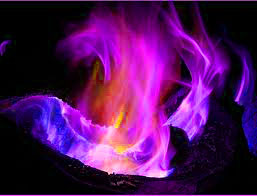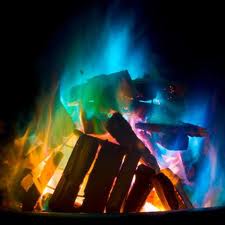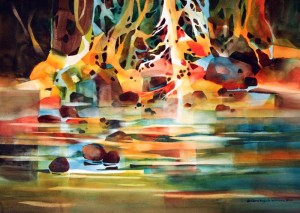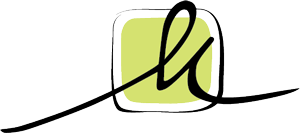 The natural colors of flames flow from red through orange, yellow and white to blue. This is the expected range of colors but what if you want something unexpected?
The natural colors of flames flow from red through orange, yellow and white to blue. This is the expected range of colors but what if you want something unexpected?
I remember logs and pine cones that burned different colors because they were soaked in certain chemicals. Each chemical produces different colors.
Here is a short science classroom video that shows the colors made by a variety of chemicals. The first minute is the most interesting, during the remaining time the fires are slowly dying out. These are the same chemicals that are used to make fireworks so I don’t recommend trying this experiment at home. Its is a rather hazardous form of color mixing!
The flame colors and the chemicals used to make them are shown below.
| Flame Color |
Chemical | ||
|---|---|---|---|
| Blue | Cupric chloride, 125g | ||
| Red | Lithium chloride, 100g | ||
| Strontium chloride, 100g | |||
| Green | Copper sulfate, 500g | ||
| Borax (Sodium borate), 1lb. | |||
| Orange | Calcium chloride, 500g | ||
| Purple | Potassium chloride, 100g | ||
| Yellow | Sodium chloride, 500g | ||
| Sodium carbonate, 1lb. |
 An easier, cheaper, and safer way to see colored flames is to order a few Mystical Color mini packets the next time you order books from Amazon. These inexpensive packets contain a mixture of chemicals. Toss a few on a campfire and beautiful colors will appear as if by magic.
An easier, cheaper, and safer way to see colored flames is to order a few Mystical Color mini packets the next time you order books from Amazon. These inexpensive packets contain a mixture of chemicals. Toss a few on a campfire and beautiful colors will appear as if by magic.
A gorgeous photo of colored flames taken by Tori Snow during a camping trip is available on Red Bubble. (RedBubble is an art community featuring wall art, design, t-shirts and photography by artists worldwide. Check it out.)
To color a campfire or not to color a campfire, that is the question. Myself, I much prefer the natural colors of fire over the artificial. But I can see a place for pushing colors to be more vivid. Even though they are not natural, they are beautiful.
 I took my first watercolor class this summer. The teacher was my neighbor, Chris Keylock Williams. A nationally known painter, Williams use of color has become more and more free over the years. The best advice she gave to all of us painting in her stunning garden was “Don’t worry about matching the colors of the paint to the colors that you see. Its about lights and darks and the feeling of the painting – the colors can be anything you want.”
I took my first watercolor class this summer. The teacher was my neighbor, Chris Keylock Williams. A nationally known painter, Williams use of color has become more and more free over the years. The best advice she gave to all of us painting in her stunning garden was “Don’t worry about matching the colors of the paint to the colors that you see. Its about lights and darks and the feeling of the painting – the colors can be anything you want.”


0 Comments
1 Pingback